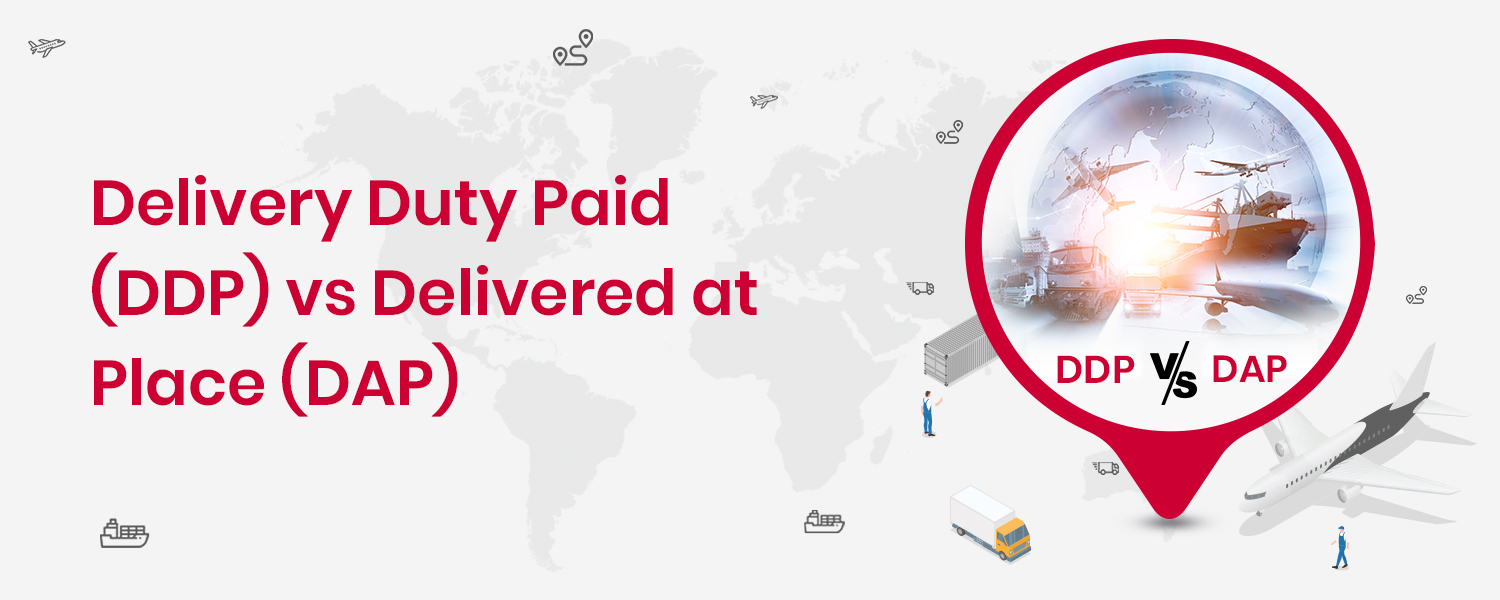DDP and DAP are terms that may seem like mere acronyms but are, in fact, pivotal players in the success of your eCommerce business. With 60% of online shoppers making international purchases, understanding the nuanced differences between Delivered Duty Paid (DDP) and Delivery at Place (DAP) is the bedrock of building a thriving eCommerce brand that transcends borders.
For B2B eCommerce brands, choosing between these two is like selecting the right tempo—each has its time and place, and each can lead to success. This blog post is your guide, conducting you through the complex score of DDP vs DAP.
DDP (Delivered Duty Paid)
DDP signifies that the seller delivers the goods to a designated destination, taking on all the costs and risks involved in the process, including transportation fees, export and import duties, and any other charges incurred along the way. This means the seller is responsible for the heavy lifting of logistics, from the point of origin right up to the buyer’s doorstep. Under DDP, the final handover to the buyer occurs only when the goods are cleared for import and ready for unloading at the agreed-upon location.
From the seller’s perspective, the obligations under DDP are extensive. They must navigate the complexities of export and import formalities, arrange for secure and efficient transportation, handle customs clearances, and pay all duties and taxes. For customers on the receiving end, goods shipped under DDP terms arrive without the hassle and unpredictability of additional fees. This can significantly enhance the customer experience, as the price paid at the point of sale is the total cost of acquiring the product.
DAP (Delivery at Place)
DAP, succinctly put, is an Incoterm where the seller delivers the goods, ready for unloading, to a destination specified by the buyer. However, the seller’s responsibility ends once the goods arrive at the named location, ready for unloading from the arriving means of transport.
The seller must cover all costs and risks of bringing the goods to the specified location, including transportation fees and handling charges. However, once the goods have reached their destination, the baton of responsibility is passed to the buyer, who must then handle import duties, taxes, and any subsequent transportation within the destination country.
From the customer’s perspective, especially in a B2B context, DAP terms mean that while the initial part of the journey is taken care of, they must be prepared to tackle the import process. This could potentially mean unexpected costs and bureaucratic hurdles that could disrupt their operations.
DDP vs DAP: Key Differences and Their Implications
Comparative Analysis: DDP vs DAP
DDP and DAP represent two divergent paths in the journey of an international shipment. Under DDP, sellers carry the responsibility to the buyer’s doorstep, bearing all risks and costs, including customs duties and taxes. Conversely, DAP is akin to a relay race where sellers hand over the responsibility at the threshold of the destination country, leaving buyers to navigate the final stretch, including import duties and unloading of goods.
Shipping Responsibilities and Costs
In DDP, sellers must meticulously manage logistics and financial outlays, ensuring that every aspect of the shipment, from packaging to delivery and acquiring import-export code, adheres to regulatory compliance across borders. The cost implications are significant, often reflected in the product pricing to mitigate the financial burden shouldered by sellers.
In contrast, DAP delineates the seller’s responsibilities at the delivery destination point. Here, buyers must flex their logistical muscles, taking on the cost and coordination of import duties, taxes, and the final delivery leg.
Risk Allocation Between DDP and DAP
DDP places the onus of risk entirely upon the seller until the goods are safely in the buyer’s hands, a commitment that necessitates a robust risk management strategy in international shipping.
DAP, however, introduces buyers to the risk once goods disembark in the destination country. This necessitates a keen understanding of local customs regulations and a readiness to tackle any logistical challenges that may arise, from unexpected tariffs to storage fees.
Cost Implications for Sellers and Buyers
DDP signifies a significant financial undertaking for sellers, requiring a comprehensive understanding of all costs involved in delivering goods internationally.
Under DAP, buyers must prepare to bear the additional costs of import duties and potential handling charges.
Conclusion: Making the Right Choice for Your Business
Deciding between DDP and DAP requires a strategic approach. E-commerce businesses should consider factors such as their familiarity with the import regulations of the buyer’s country, the ability to absorb additional costs, the nature of their products, and their customers’ preferences. Questions like “Can we efficiently manage the logistics and customs processes required under DDP?” or “Do our customers prefer to handle import duties themselves, as in DAP?” can guide businesses toward making an informed decision.
Moreover, to make international shipping hassle-free, there are cross-border shipping platforms like NimbusPost. Leveraging these platforms will give you an extensive network of countries to deliver products, easy customs clearance, logistics partners, insurance coverage, and faster deliveries.
Learn more about Export Incentives Schemes & their Benefits.
FAQs
Is DAP better than DDP?
Yes, for many sellers, DAP is better. Sellers may prefer DAP to save costs and have more control over the shipping process.
What is the difference between DAP DDU and DDP?
DDP: Delivered Duty Paid. The seller pays all import fees before the import crosses borders. This includes duties, import clearance, and any taxes.
DAP: Delivered At Place. The seller is responsible for all costs except duty taxes and customs clearance in the importing country.
DDU: Delivered Duties Unpaid. Upon delivery, the buyer pays all import customs clearance, duties, and taxes.
What is the difference between DAP, DPU, and DDP?
In DAP and DDP, the seller delivers, not unloaded, whereas in DPU, the seller delivers unloaded.
Who pays for DAP shipping?
The seller pays for all freight charges in Delivered At Place (DAP) shipping.




